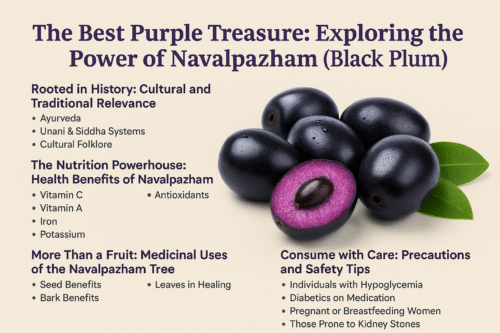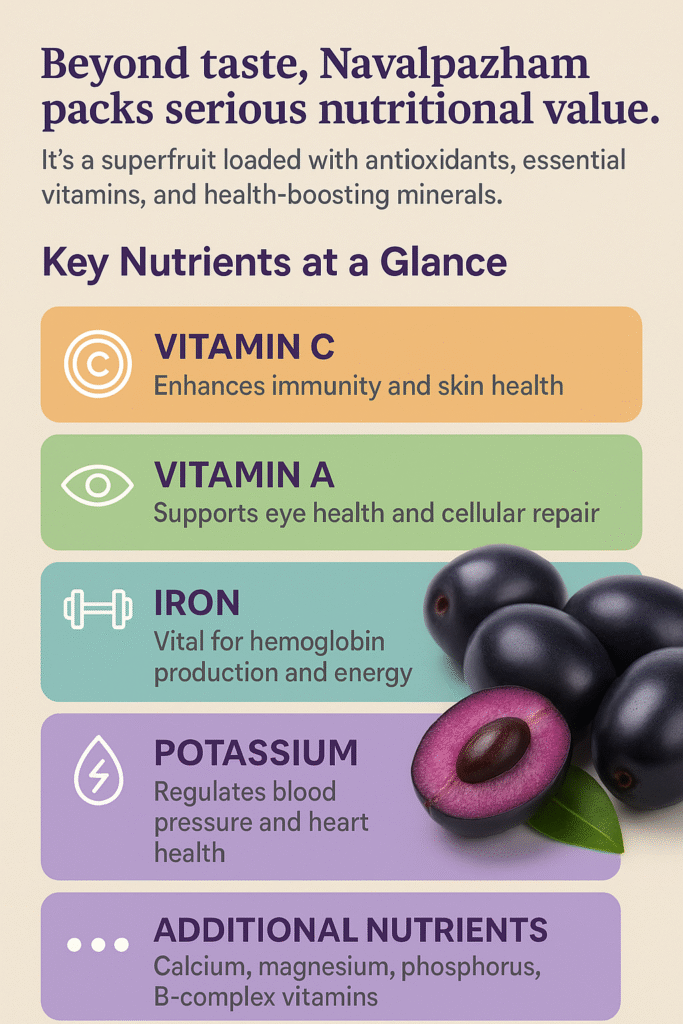Table of Contents
Introduction
Navalpazham ( Black Plum) is also called Jamun, Java Plum, and Indian Blackberry. From its vibrant appearance and unique sweet-tart taste, the article explores its rich historical and cultural significance in India and Southeast Asia. It meticulously details the fruit’s impressive nutritional profile, highlighting key vitamins and minerals, and elaborates on its numerous health benefits, including blood sugar management, digestive support, immune boosting, and benefits for skin and hair. Beyond the fruit itself, the post uncovers the traditional medicinal uses of various parts of the Navalpazham tree, such as the seeds (often used for diabetes), bark, and leaves. Finally, it provides crucial information on potential side effects and precautions, ensuring readers can enjoy this “purple powerhouse” safely and responsibly.
Rooted in History: Cultural and Traditional Relevance
Navalpazham has been cherished for generations, not just as a delicious summer fruit but also as a part of India’s spiritual and holistic heritage. Its deep ties with traditional healing and folklore make it a revered component in many indigenous practices.
Ancient Wisdom in Modern Times
- Ayurveda is a time-tested remedy for regulating blood sugar, improving digestion, and enhancing liver health. Every part of the tree, from the bark to the seed, is used therapeutically.
- Unani & Siddha Systems: These ancient healing systems also praise Navalpazham for its role in detoxification, balancing metabolism, and purifying blood.
- Cultural Folklore: Frequently found in local stories and idioms, the Jamun tree is often seen as a metaphor for strength, nourishment, and playful mischief.
The Nutrition Powerhouse: Health Benefits of Navalpazham
Beyond taste, navalpazham packs serious nutritional value. It’s a superfruit loaded with antioxidants, essential vitamins, and health-boosting minerals.
Key Nutrients at a Glance
- Vitamin C—Enhances immunity and skin health
- Vitamin A—Supports eye health and cellular repair
- Iron—Vital for hemoglobin production and energy
- Potassium—Regulates blood pressure and heart health
- Additional Nutrients—Calcium, magnesium, phosphorus, B-complex vitamins
Antioxidants for Longevity
The vibrant color of Navalpazham is due to anthocyanins, powerful antioxidants that fight oxidative stress, protect cells, and support anti-aging and disease prevention.
Health Benefits of Navalpazham
- Blood Sugar Management (Especially for Diabetes): Perhaps its most celebrated benefit. Navalpazham, particularly its seeds, contains compounds like jamboline and jambosine that are believed to help slow down the conversion of starch into sugar, potentially reducing blood glucose levels. It also has a low glycemic index, making it a favorable fruit for individuals managing diabetes. It’s important to note that while beneficial, it should not replace prescribed medication or medical advice.
- Digestive Health: The astringent properties of Navalpazham can help firm up stools, making it beneficial for mild diarrhea. Its fiber content aids in promoting regular bowel movements and preventing constipation, contributing to a healthy gut microbiome.
- Liver Health: Traditional medicine often employs Navalpazham for its potential to support liver function and protect against liver damage due to its antioxidant content.
- Boosting Immunity: Thanks to its high Vitamin C content and other antioxidants, Navalpazham plays a significant role in strengthening the body’s immune system, helping it ward off infections and illnesses.
- Potential Anti-inflammatory and Anti-allergic Properties: The presence of various bioactive compounds suggests that Navalpazham may possess properties that help reduce inflammation and alleviate allergic reactions, though more research is always ongoing.
- Benefits for Skin and Hair: The rich antioxidant profile, coupled with vitamins A and C, contributes to healthier skin by fighting free radical damage, promoting collagen production, and potentially reducing acne. For hair, the nutrients can help strengthen follicles and promote overall hair health.
Incorporating navalpazham into your diet, especially during its season, is a delicious way to harness these incredible health benefits and support your overall well-being.
More Than a Fruit: Medicinal Uses of the Navalpazham Tree
The healing power of the Syzygium cumini tree extends to its bark, seeds, and leaves—each offering unique wellness properties.
Seed Benefits
- Controls Blood Sugar: Dried and powdered seeds are traditionally used for diabetes control.
- Improves Digestion: Astringent qualities help in managing dysentery and diarrhea.
- Detoxifying Agent: Often used in cleansing formulations in traditional medicine.
Bark Benefits
- Oral Health: Bark decoctions help soothe gum infections, sore throats, and ulcers.
- Digestive Support: Used for its anti-diarrheal properties.
- Wound Healing: Topical use may aid minor cuts and skin conditions.
Leaves in Healing
- Regulate Blood Sugar: Leaf extracts are also used in diabetes remedies.
- Soothe the Stomach: Leaf infusions help relieve mild gastric discomfort.
- Anti-inflammatory and Antibacterial: Used in traditional treatments for swelling, rashes, and minor infections.
Consume with Care: Precautions and Safety Tips
Although Navalpazham is packed with goodness, certain groups should be cautious.
Who Should Be Cautious?
- People with hypoglycemia may further lower blood sugar levels.
- Diabetics on medication: Potential risk of hypoglycemia—consult your doctor.
- Pregnant or Breastfeeding Women: Limited research; best to consult a healthcare provider.
- Those Prone to Kidney Stones: Oxalic acid content may aggravate the condition.
- Very Young Children: A strong astringent taste may cause digestive irritation.
Consumption Guidelines
- Ideal Intake: 100–150 g per day is generally safe for healthy adults.
- Best Time: After meals to avoid acidity.
- Avoid with Milk: Traditional advice suggests not mixing with dairy to prevent digestion issues.
- Seed Caution: Do not swallow whole seeds; only consume processed or powdered form when advised.
Conclusion: Celebrate the Legacy of Navalpazham
Navalpazham, with its royal hue and legacy of wellness, is a shining example of how nature provides both nourishment and healing. From sweet-sour bites that stain your tongue to its legacy in Ayurveda and folklore, this fruit embodies flavor, health, and history.
Whether you enjoy it as a fresh snack, juice, or part of a traditional remedy, incorporating Navalpazham into your diet is a delightful way to honor both your palate and your health.
Have a favorite recipe or memory with jamun? Share it in the comments! Let’s celebrate this purple powerhouse together.





